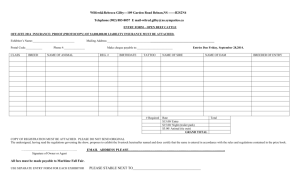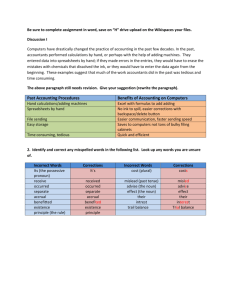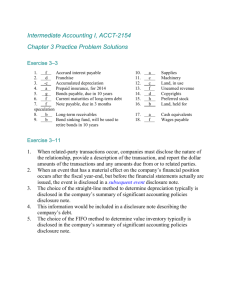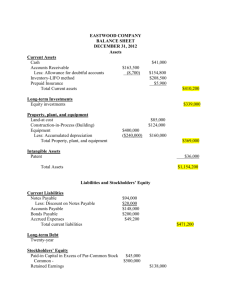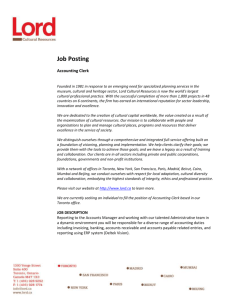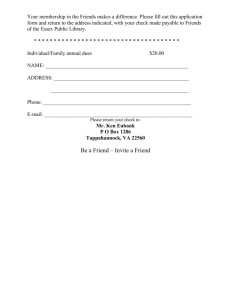CHAPTER 11 Current Liabilities and Payroll Accounting
advertisement
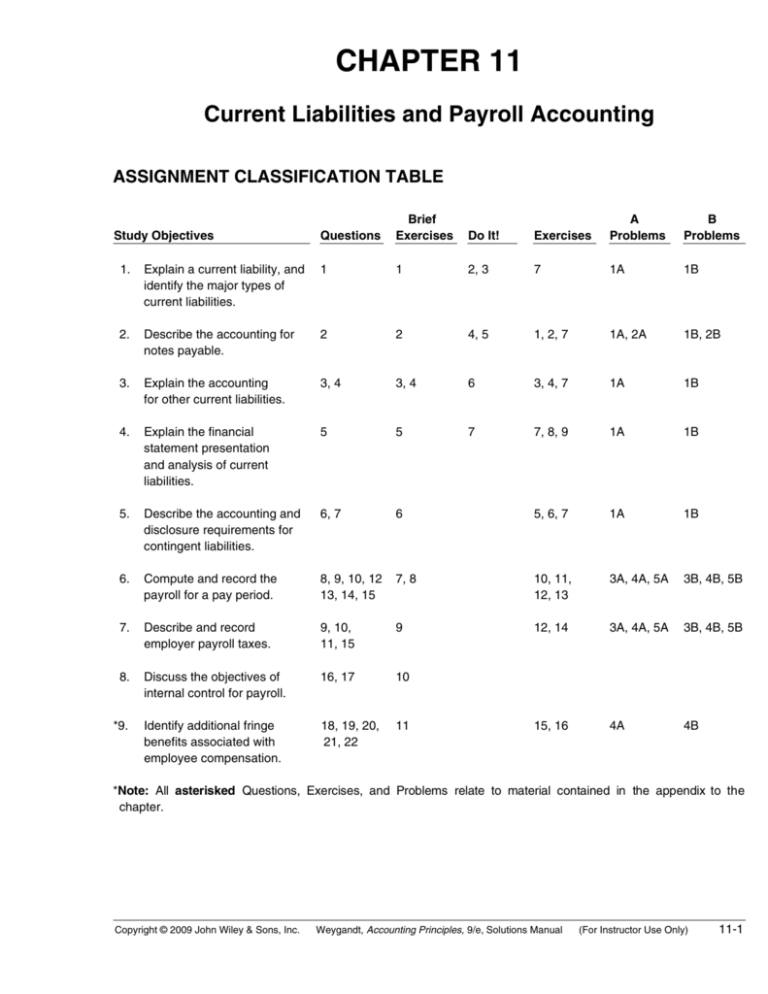
CHAPTER 11 Current Liabilities and Payroll Accounting ASSIGNMENT CLASSIFICATION TABLE Study Objectives Questions Brief Exercises Do It! Exercises A Problems B Problems 1. Explain a current liability, and identify the major types of current liabilities. 1 1 2, 3 7 1A 1B 2. Describe the accounting for notes payable. 2 2 4, 5 1, 2, 7 1A, 2A 1B, 2B 3. Explain the accounting for other current liabilities. 3, 4 3, 4 6 3, 4, 7 1A 1B 4. Explain the financial statement presentation and analysis of current liabilities. 5 5 7 7, 8, 9 1A 1B 5. Describe the accounting and disclosure requirements for contingent liabilities. 6, 7 6 5, 6, 7 1A 1B 6. Compute and record the payroll for a pay period. 8, 9, 10, 12 13, 14, 15 7, 8 10, 11, 12, 13 3A, 4A, 5A 3B, 4B, 5B 7. Describe and record employer payroll taxes. 9, 10, 11, 15 9 12, 14 3A, 4A, 5A 3B, 4B, 5B 8. Discuss the objectives of internal control for payroll. 16, 17 10 Identify additional fringe benefits associated with employee compensation. 18, 19, 20, 21, 22 11 15, 16 4A 4B *9. *Note: All asterisked Questions, Exercises, and Problems relate to material contained in the appendix*to the chapter. Copyright © 2009 John Wiley & Sons, Inc. Weygandt, Accounting Principles, 9/e, Solutions Manual (For Instructor Use Only) 11-1 ASSIGNMENT CHARACTERISTICS TABLE Problem Number Description Difficulty Level Time Allotted (min.) 1A Prepare current liability entries, adjusting entries, and current liabilities section. Moderate 30–40 2A Journalize and post note transactions and show balance sheet presentation. Moderate 30–40 3A Prepare payroll register and payroll entries. Simple 30–40 4A Journalize payroll transactions and adjusting entries. Moderate 30–40 5A Prepare entries for payroll and payroll taxes; prepare W-2 data. Moderate 30–40 1B Prepare current liability entries, adjusting entries, and current liabilities section. Moderate 30–40 2B Journalize and post note transactions and show balance sheet presentation. Moderate 30–40 3B Prepare payroll register and payroll entries. Simple 30–40 4B Journalize payroll transactions and adjusting entries. Moderate 30–40 5B Prepare entries for payroll and payroll taxes; prepare W-2 data. Moderate 30–40 11-2 Copyright © 2009 John Wiley & Sons, Inc. Weygandt, Accounting Principles, 9/e, Solutions Manual (For Instructor Use Only) WEYGANDT ACCOUNTING PRINCIPLES 9E CHAPTER 11 CURRENT LIABILITIES AND PAYROLL ACCOUNTING Number SO BT Difficulty Time (min.) BE1 1 C Simple 3–5 BE2 2 AP Simple 2–4 BE3 3 AP Simple 2–4 BE4 3 AP Simple 2–4 BE5 4 AP Simple 2–4 BE6 5 AN Simple 1–2 BE7 6 AP Simple 3–5 BE8 6 AP Simple 3–5 BE9 7 AP Simple 2–4 BE10 8 C Simple 2–4 BE11 9 AP Simple 2–4 DI1 2, 3 C Simple 6–8 DI2 4, 5 AP Simple 8–10 DI3 6 AP Simple 3–5 DI4 7 AP Simple 3–5 EX1 2 AN Moderate 8–10 EX2 2 AN Simple 6–8 EX3 3 AP Simple 4–6 EX4 3 AN Simple 6–8 EX5 5 AN Moderate 8–10 EX6 5 C Simple 8–10 EX7 1–5 AP Simple 6–8 EX8 4 AP Simple 4–6 EX9 4 AP Simple 6–8 EX10 6 AP Simple 8–10 EX11 6 AP Simple 6–8 EX12 6, 7 AP Moderate 12–15 EX13 6 AP Moderate 10–12 EX14 7 AP Simple 6–8 Copyright © 2009 John Wiley & Sons, Inc. Weygandt, Accounting Principles, 9/e, Solutions Manual (For Instructor Use Only) 11-3 CURRENT LIABILITIES AND PAYROLL ACCOUNTING (Continued) Number SO BT Difficulty Time (min.) EX15 9 AN Simple 3–5 EX16 9 AP Simple 4–6 P1A 1–5 AN Moderate 30–40 P2A 2 AN Moderate 30–40 P3A 6, 7 AN Simple 30–40 P4A 6, 7, 8 AN Moderate 30–40 P5A 6, 7 AN Moderate 30–40 P1B 1–5 AN Moderate 30–40 P2B 2 AN Moderate 30–40 P3B 6, 7 AN Simple 30–40 P4B 6, 7, 9 AN Moderate 30–40 P5B 6, 7 AN Moderate 30–40 BYP1 4, 5 C Simple 10–15 BYP2 4 AN, E Simple 10–15 BYP3 6, 7 C Simple 15–20 BYP4 6, 7 E Moderate 15–20 BYP5 7 C Simple 10–15 BYP6 8 E Simple 10–15 BYP7 6, 7 AN Moderate 15–20 11-4 Copyright © 2009 John Wiley & Sons, Inc. Weygandt, Accounting Principles, 9/e, Solutions Manual (For Instructor Use Only) Copyright © 2009 John Wiley & Sons, Inc. Weygandt, Accounting Principles, 9/e, Solutions Manual Q11-16 BE11-10 Q11-17 8. Discuss the objectives of internal control for payroll. Broadening Your Perspective Financial Reporting Communication Exploring the Web Q11-22 BE11-11 E11-16 BE11-9 E11-14 P11-3A P11-4A DI11-4 P11-5A E11-12 Q11-9 Q11-10 Q11-15 Q11-11 7. Describe and record employer payroll taxes. Q11-19 Q11-20 Q11-21 P11-3B P11-4B P11-5B Q11-15 BE11-7 E11-11 P11-3A BE11-8 E11-12 P11-4A DI11-3 E11-13 P11-5A E11-10 Q11-8 Q11-10 Q11-13 Q11-9 Q11-12 Q11-14 6. Compute and record the payroll for a pay period. Q11-18 P11-3B P11-4B P11-5B BE11-6 E11-5 DI11-2 E11-7 Q11-6 Q11-7 E11-6 5. Describe the accounting and disclosure requirements for contingent liabilities. *9. Identify additional fringe benefits associated with employee compensation. P11-1A P11-1B P11-1A P11-1B BE11-5 E11-8 DI11-2 E11-9 E11-7 Q11-5 4. Explain the financial statement presentation and analysis of current liabilities. Comparative Analysis E11-15 P11-4A P11-4B E11-3 BE11-3 E11-7 E11-4 P11-1A P11-1B Q11-3 Q11-4 BE11-4 DI11-1 P11-2A P11-1B P11-2B 3. Explain the accounting for other current liabilities. BE11-2 E11-1 E11-2 P11-1A E11-7 P11-1A P11-1B Analysis Q11-2 DI11-1 E11-7 Application 2. Describe the accounting for notes payable. Comprehension Q11-1 BE11-1 Knowledge 1. Explain a current liability, and identify the major types of current liabilities. Study Objective Synthesis Decision Making Across the Organization Ethics Case All About You Evaluation Correlation Chart between Bloom’s Taxonomy, Study Objectives and End-of-Chapter Exercises and Problems BLOOM’S TAXONOMY TABLE (For Instructor Use Only) 11-5 ANSWERS TO QUESTIONS 1. Jill is not correct. A current liability is a debt that can reasonably be expected to be paid: (a) from existing current assets or through the creation of other current liabilities and (2) within one year or the operating cycle, whichever is longer. 2. In the balance sheet, Notes Payable of $40,000 and Interest Payable of $900 ($40,000 X .09 X 3/12) should be reported as current liabilities. In the income statement, Interest Expense of $900 should be reported under other expenses and losses. 3. (a) Disagree. The company only serves as a collection agent for the taxing authority. It does not report sales taxes as an expense; it merely forwards the amount paid by the customer to the government. (b) The entry to record the proceeds is: Cash.......................................................................................................... 7,400 Sales................................................................................................ 7,000 Sales Taxes Payable.................................................................... 400 4. (a) The entry when the tickets are sold is: Cash.......................................................................................................... Unearned Football Ticket Revenue........................................... (b) The entry after each game is: Unearned Football Ticket Revenue .................................................... Football Ticket Revenue .............................................................. 800,000 800,000 160,000 160,000 5. Liquidity refers to the ability of a company to pay its maturing obligations and meet unexpected needs for cash. Two measures of liquidity are working capital (current assets – current liabilities) and the current ratio (current assets ÷ current liabilities). 6. A contingent liability is a potential liability that may become an actual liability in the future. Contingent liabilities are only recorded in the accounts if they are probable and the amount is reasonably estimable. Warranty costs are a contingent liability usually recorded in the accounts since they are both probable in incurrence and subject to estimation. 7. If an event is only reasonably possible, then only note disclosure is required. If the possibility of a contingent liability occurring is only remote, then neither recording in the accounts nor note disclosure is required. 8. Gross pay is the amount an employee actually earns. Net pay, the amount an employee is paid, is gross pay reduced by both mandatory and voluntary deductions, such as FICA taxes, union dues, federal income taxes, etc. Gross pay should be recorded as wages or salaries expense. 9. Both employees and employers are required to pay FICA taxes. 10. 11-6 No. When an employer withholds federal or state income taxes from employee paychecks, the employer is merely acting as a collection agent for the taxing body. Since the employer holds employees’ funds, these withholdings are a liability for the employer until they are remitted to the government. Copyright © 2009 John Wiley & Sons, Inc. Weygandt, Accounting Principles, 9/e, Solutions Manual (For Instructor Use Only) Questions Chapter 11 (Continued) 11. FICA stands for Federal Insurance Contribution Act; FUTA stands for Federal Unemployment Tax Act; and SUTA stands for State Unemployment Tax Act. 12. A W-2 statement contains the employee’s name, address, social security number, wages, tips, other compensation, social security taxes withheld, wages subject to social security taxes, and federal, state and local income taxes withheld. 13. Payroll deductions can be classified as either mandatory (required by the government) or voluntary (not required by the government). Mandatory deductions include FICA taxes and income taxes. Examples of voluntary deductions are health and life insurance premiums, pension contributions, union dues, and charitable contributions. 14. The employee earnings record is used in: (1) determining when an employee has earned the maximum earnings subject to FICA taxes, (2) filing state and federal payroll tax returns, and (3) providing each employee with a statement of gross earnings and tax withholdings for the year. 15. (a) The three types of taxes are: (1) FICA, (2) federal unemployment, and (3) state unemployment. (b) The tax liability accounts are classified as current liabilities in the balance sheet. Payroll tax expense is classified under operating expenses in the income statement. 16. The main internal control objectives associated with payrolls are: (1) to safeguard company assets from unauthorized payments of payrolls and (2) to assure the accuracy and reliability of the accounting records pertaining to payrolls. 17. The four functions associated with payroll are: (1) hiring employees, (2) timekeeping, (3) preparing the payroll, and (4) paying the payroll. *18. Two additional types of fringe benefits are: (1) Paid absences—vacation pay, sick pay, and paid holidays. (2) Post-retirement benefits—pensions and health care and life insurance. *19. Paid absences refer to compensation paid by employers to employees for vacations, sickness, and holidays. When the payment of such compensation is probable and the amount can be reasonably estimated, a liability should be accrued for paid future absences which employees have earned. When this amount cannot be reasonably estimated, the potential liability should be disclosed. *20. Post-retirement benefits consist of payments by employers to retired employees for: (1) pensions and (2) health care and life insurance. *21. A 401(K) works as follows: an employee can contribute up to a certain percentage of pay into a 401(K) plan and employers will match a percentage of the employee’s contribution. *22. A defined contribution plan defines the contribution that an employer will make but not the benefit that the employee will receive. In a defined benefit plan, the employer agrees to pay a defined amount to retirees based on employees meeting certain eligibility standards. Copyright © 2009 John Wiley & Sons, Inc. Weygandt, Accounting Principles, 9/e, Solutions Manual (For Instructor Use Only) 11-7 SOLUTIONS TO BRIEF EXERCISES BRIEF EXERCISE 11-1 (a) A note payable due in two years is a long-term liability, not a current liability. (b) $30,000 of the mortgage payable is a current maturity of long-term debt. This amount should be reported as a current liability. (c) Interest payable is a current liability because it will be paid out of current assets in the near future. (d) Accounts payable is a current liability because it will be paid out of current assets in the near future. BRIEF EXERCISE 11-2 July 1 Dec. 31 Cash.............................................................................. Notes Payable................................................... 80,000 Interest Expense....................................................... Interest Payable ($80,000 X 10% X 1/2)................................. 4,000 80,000 4,000 BRIEF EXERCISE 11-3 Sales tax payable (1) Sales = $14,800 = ($15,540 ÷ 1.05) (2) Sales taxes payable = $740 = ($14,800 X 5%) Mar. 16 11-8 Cash .............................................................................. Sales ...................................................................... Sales Taxes Payable......................................... Copyright © 2009 John Wiley & Sons, Inc. 15,540 Weygandt, Accounting Principles, 9/e, Solutions Manual 14,800 740 (For Instructor Use Only) BRIEF EXERCISE 11-4 Cash............................................................................................... Unearned Basketball Ticket Revenue ....................... (To record sale of 4,000 season tickets) 720,000 Unearned Basketball Ticket Revenue ................................ Basketball Ticket Revenue............................................ (To record basketball ticket revenues earned) 60,000 720,000 60,000 BRIEF EXERCISE 11-5 (a) Working capital = $3,449,533 – $1,204,052 = $2,245,481 (thousand) (b) Current ratio = $3,449,533 ÷ $1,204,052 = 2.86:1 BRIEF EXERCISE 11-6 Dec. 31 Warranty Expense ................................................ Estimated Warranty Liability.................... [(1,000 X 5%) X $80] 4,000 4,000 BRIEF EXERCISE 11-7 Gross earnings: Regular pay (40 X $16).................................................... Overtime pay (7 X $24) ................................................... Gross earnings .......................................................................... Less: FICA taxes payable ($808 X 8%) ............................. Federal income taxes payable................................. Net pay.......................................................................................... Copyright © 2009 John Wiley & Sons, Inc. Weygandt, Accounting Principles, 9/e, Solutions Manual $640.00 168.00 $808.00 $808.00 $ 64.64 95.00 159.64 $648.36 (For Instructor Use Only) 11-9 BRIEF EXERCISE 11-8 Jan. 15 Jan. 15 Wages Expense......................................................... FICA Taxes Payable ($808 X 8%)................ Federal Income Taxes Payable ................... Wages Payable ................................................. 808.00 Wages Payable .......................................................... Cash ..................................................................... 648.36 64.64 95.00 648.36 648.36 BRIEF EXERCISE 11-9 Jan. 31 Payroll Tax Expense ................................................ FICA Taxes Payable ($70,000 X 8%) ............. Federal Unemployment Taxes Payable ($70,000 X .8%) ............................ State Unemployment Taxes Payable ($70,000 X 5.4%)........................................... 9,940 5,600 560 3,780 BRIEF EXERCISE 11-10 (a) Timekeeping (b) Hiring employees (c) Preparing the payroll (d) Paying the payroll *BRIEF EXERCISE 11-11 Jan. 31 Vacation Benefits Expense (80 X $120).......... Vacation Benefits Payable......................... 9,600 9,600 SOLUTIONS FOR DO IT! REVIEW EXERCISES DO IT! 11-1 1. 2. 3. 11-10 $70,000 X 12% X 5/12 = $3,500 $42,000/1.05 = $40,000; $40,000 X 5% = $2,000 $42,000 X 2/6 = $14,000 Copyright © 2009 John Wiley & Sons, Inc. Weygandt, Accounting Principles, 9/e, Solutions Manual (For Instructor Use Only) DO IT! 11-2 (a) Current liabilities Notes payable due in 2011 ..................................... Accounts payable...................................................... Long-term debt due within one year ................... Lawsuit liability .......................................................... Unearned revenue ..................................................... Salaries payable......................................................... Utilities payable.......................................................... Total current liabilities...................................... $ 40,000 50,000 90,000 85,000 70,000 32,000 13,000 $380,000 (b) Working capital = Current assets – Current liabilities = $570,000 – $380,000 = $190,000 Current ratio: Current assets ÷ Current liabilities = $570,000 ÷ $380,000 = 1.50:1 DO IT! 11-3 (a) Net pay: $60,000 – (8% X $60,000) – $14,000 – $1,600 = $39,600 (b) Salaries and Wages Expense....................................... FICA Taxes Payable................................................... Federal Income Taxes Payable.............................. State Income Taxes Payable................................... Salaries and Wages Payable .................................. 60,000 4,800 14,000 1,600 39,600 DO IT! 11-4 Payroll Tax Expense ................................................................ FICA Taxes Payable ........................................................ Federal Unemployment Taxes Payable .................... State Unemployment Taxes Payable......................... Copyright © 2009 John Wiley & Sons, Inc. Weygandt, Accounting Principles, 9/e, Solutions Manual 15,620 8,800 880 5,940 (For Instructor Use Only) 11-11 SOLUTIONS TO EXERCISES EXERCISE 11-1 July 1, 2010 Cash ................................................................................... Notes Payable ......................................................... 50,000 November 1, 2010 Cash ................................................................................... Notes Payable ......................................................... 60,000 50,000 60,000 December 31, 2010 11-12 Interest Expense ($50,000 X 12% X 6/12)............................................. Interest Payable...................................................... 3,000 Interest Expense ($60,000 X 10% X 2/12)............................................. Interest Payable...................................................... 1,000 Feburary 1, 2011 Notes Payable ................................................................. Interest Payable.............................................................. Interest Expense ............................................................ Cash ........................................................................... 60,000 1,000 500 April 1, 2011 Notes Payable ................................................................. Interest Payable.............................................................. Interest Expense ............................................................ Cash ........................................................................... 50,000 3,000 1,500 Copyright © 2009 John Wiley & Sons, Inc. 3,000 1,000 61,500 Weygandt, Accounting Principles, 9/e, Solutions Manual 54,500 (For Instructor Use Only) EXERCISE 11-2 (a) June 1 Cash.................................................................... Notes Payable.......................................... 90,000 (b) June 30 Interest Expense............................................. Interest Payable [($90,000 X 12%) X 1/12] ................. 900 (c) Dec. 1 Notes Payable.................................................. Interest Payable ($90,000 X 12% X 6/12) ............................. Cash............................................................ 90,000 90,000 900 5,400 95,400 (d) $5,400 EXERCISE 11-3 Apr. 10 15 WARKENTINNE COMPANY Cash........................................................................... Sales ................................................................. Sales Taxes Payable ................................... RIVERA COMPANY Cash........................................................................... Sales ($23,540 ÷ 1.07) ................................. Sales Taxes Payable ($23,540 – $22,000) .................................. Copyright © 2009 John Wiley & Sons, Inc. Weygandt, Accounting Principles, 9/e, Solutions Manual 31,500 30,000 1,500 23,540 22,000 1,540 (For Instructor Use Only) 11-13 EXERCISE 11-4 (a) Nov. 30 (b) Dec. 31 (c) Mar. 31 Cash...................................................................... 240,000 Unearned Subscriptions (12,000 X $20)....................................... Unearned Subscriptions................................ Subscription Revenue ($240,000 X 1/12) ................................. 20,000 Unearned Subscriptions ................................ Subscription Revenue ($240,000 X 3/12).................................. 60,000 240,000 20,000 60,000 EXERCISE 11-5 (a) Estimated warranties outstanding: Month Estimate Units Defective Outstanding November December Total 900 960 1,860 600 400 1,000 300 560 860 Estimated warranty liability—860 X $20 = $17,200. (b) Warranty Expense (1,860 X $20)...................................... Estimated Warranty Liability.................................... 37,200 Estimated Warranty Liability............................................. Repair Parts, Wages Payable, Cash, etc.............. 20,000 (c) Estimated Warranty Liability (500 X $20)...................... Repair Parts, Wages Payable, Cash, etc.............. 10,000 11-14 Copyright © 2009 John Wiley & Sons, Inc. 37,200 20,000 Weygandt, Accounting Principles, 9/e, Solutions Manual 10,000 (For Instructor Use Only) EXERCISE 11-6 (a) If a contingency is remote (unlikely to occur), it need not be recorded or disclosed. (b) Since the contingency is probable and reasonably estimable, the liability should be recorded in the accounts. In addition, the details should be disclosed in the notes to the financial statements. The journal entry is: Lawsuit Loss ........................................................ Lawsuit Liability ....................................... 1,000,000 1,000,000 (c) If a contingency is reasonably possible, it need not be recorded, but must be disclosed in the notes to the financial statements. EXERCISE 11-7 (a) JEWETT ONLINE COMPANY Partial Balance Sheet Current liabilities Accounts payable .................................................................... Mortgage payable due within one year............................. Unearned ticket revenue........................................................ Estimated warranty liability .................................................. Sales taxes payable................................................................. Interest payable ........................................................................ Total current liabilities................................................... $ 63,000 30,000 24,000 18,000 10,000 8,000 $153,000 (b) Jewett Online Company’s working capital is $147,000 and its current ratio is 1.96:1. Although a current ratio of 2:1 has been considered the standard for a good credit rating, many companies operate successfully with a current ratio below 2:1. EXERCISE 11-8 (a) Working capital = $6,755 – $7,581 = ($826) million (b) Current ratio = $6,755 ÷ $7,581 = .89:1 Copyright © 2009 John Wiley & Sons, Inc. Weygandt, Accounting Principles, 9/e, Solutions Manual (For Instructor Use Only) 11-15 EXERCISE 11-9 (a) Current ratio 2006 $8,946 ÷ $7,323 = 1.22:1 2007 $9,838 ÷ $5,362 = 1.83:1 Working capital 2006 $8,946 – $7,323 = $1,623 million 2007 $9,838 – $5,362 = $4,476 million (b) Current ratio $9,638 ÷ $5,162 = 1.87:1 Working capital $9,638 – $5,162 = $4,476 million It would make its current ratio increase slightly, but its working capital would remain the same. EXERCISE 11-10 (a) 1. Regular 40 X $15.00 = $600.00 Overtime 2 X $22.50 = 45.00 Gross earnings $645.00 2. FICA taxes—$51.60 = ($645 X 8%). 3. Federal income taxes $55. 4. State income taxes $12.90 = ($645 X 2%). 5. Net pay $500.50 = ($645.00 – $51.60 – $55.00 – $12.90 – $25.00). (b) Office Wages Expense....................................................... FICA Taxes Payable ................................................... Federal Income Taxes Payable .............................. State Income Taxes Payable................................... Health Insurance Payable ........................................ Wages Payable ............................................................ 11-16 Copyright © 2009 John Wiley & Sons, Inc. 645.00 Weygandt, Accounting Principles, 9/e, Solutions Manual 51.60 55.00 12.90 25.00 500.50 (For Instructor Use Only) EXERCISE 11-11 C. Ogle $4,000 X 8% = $320. Ogle’s total gross earnings for the year are $97,500 = ($93,500 + $4,000), which is below the $100,000 maximum for FICA taxes. D. Delgado $3,900 X 8% = $312. Delgado’s total gross earnings for the year are $100,100. Thus, $3,900 of the gross earnings ($4,000 – $100) for this pay period are subject to FICA taxes. L. Jeter $2,400 X 8% = $192. Jeter’s total gross earnings for the year are $101,600. Thus, only $2,400 of the gross earnings ($4,000 – $1,600) for this pay period are subject to FICA taxes. T. Spivey $0. Spivey’s gross earnings prior to this pay equal the maximum amount subject to FICA taxes. Thus, none of the gross earnings in the December 31 pay period is subject to FICA taxes. EXERCISE 11-12 (a) See next page. (b) Jan. 31 Jan. 31 Wages Expense ............................................. FICA Taxes Payable............................. Federal Income Taxes Payable........... Health Insurance Payable.................. Wages Payable...................................... Payroll Tax Expense..................................... FICA Taxes Payable............................. Federal Unemployment Taxes Payable ($1,837 X .8%) ................... State Unemployment Taxes Payable ($1,837 X 5.4%)................. Copyright © 2009 John Wiley & Sons, Inc. Weygandt, Accounting Principles, 9/e, Solutions Manual 1,837.00 146.96 129.00 60.00 1,501.04 260.86 146.96 14.70 99.20 (For Instructor Use Only) 11-17 11-18 Copyright © 2009 John Wiley & Sons, Inc. M. Hashmi E. Benson K. Kern Totals Employee (a) 46 42 44 Total Hours $ 480.00 520.00 600.00 $1,600.00 Regular $108.00 39.00 90.00 $237.00 Overtime Earnings $ 588.00 559.00 690.00 $1,837.00 Gross Pay $ 47.04 44.72 55.20 $146.96 FICA Taxes $ 34.00 37.00 58.00 $129.00 $10.00 25.00 25.00 $60.00 Deductions Federal Health Income Taxes Insurance ALVAMAR COMPANY Payroll Register For the Week Ending January 31 $ 91.04 106.72 138.20 $335.96 Total $ 496.96 452.28 551.80 $1,501.04 Net Pay EXERCISE 11-12 (Continued) Weygandt, Accounting Principles, 9/e, Solutions Manual (For Instructor Use Only) EXERCISE 11-13 (a) (1) (2) (3) (4) (5) $ 1,100 [$10,000 see (2) below – $8,900]. $10,000 (FICA taxes $800 ÷ 8%). $ 300 ($10,000 X 3%). $ 2,340 ($10,000 – $7,660). $ 6,000 ($10,000 – $4,000). (b) Feb. 28 28 Warehouse Wages Expense......................... Store Wages Expense .................................... FICA Taxes Payable ............................... Federal Income Taxes Payable .................................................. State Income Taxes Payable ............... Union Dues Payable............................... Wages Payable......................................... 6,000 4,000 Wages Payable ................................................. Cash............................................................. 7,660 800 1,140 300 100 7,660 7,660 EXERCISE 11-14 (a) FICA tax ($760,000 X 8%)................................................... SUTA tax ($100,000 X 5.4%).............................................. FUTA tax ($100,000 X 0.8%) .............................................. Total payroll tax ........................................................... (b) Payroll Tax Expense............................................................ FICA Taxes Payable.................................................... State Unemployment Taxes Payable .................... Federal Unemployment Taxes Payable ............... Copyright © 2009 John Wiley & Sons, Inc. Weygandt, Accounting Principles, 9/e, Solutions Manual $60,800 5,400 800 $67,000 67,000 60,800 5,400 800 (For Instructor Use Only) 11-19 *EXERCISE 11-15 Mar. 31 31 Vacation Benefits Expense (10 X 2 X $120)..................................................... Vacation Benefits Payable.......................... Pension Expense ($40,000 X 10%).................... Pension Liability ............................................ 2,400 2,400 4,000 4,000 *EXERCISE 11-16 1. 2. 3. 11-20 Vacation Benefits Expense............................................ Vacation Benefits Payable (20 X 5 X $120)..................................................... 12,000 Pension Expense .............................................................. Cash ............................................................................ Pension Liability ..................................................... 100,000 Vacation Benefits Payable ............................................. Cash (18 X 1 X $120)..................................................... 2,160 Copyright © 2009 John Wiley & Sons, Inc. 12,000 70,000 30,000 Weygandt, Accounting Principles, 9/e, Solutions Manual 2,160 (For Instructor Use Only) SOLUTIONS TO PROBLEMS PROBLEM 11-1A (a) Jan. 5 12 14 20 21 25 Cash...................................................................... Sales ($22,680 ÷ 108%) .......................... Sales Taxes Payable ($22,680 – $21,000) ............................. 22,680 Unearned Service Revenue........................... Service Revenue...................................... 10,000 Sales Taxes Payable ....................................... Cash............................................................. 7,700 Accounts Receivable ...................................... Sales ............................................................ Sales Taxes Payable (800 X $50 X 8%).................................. 43,200 Cash...................................................................... Notes Payable........................................... 18,000 Cash...................................................................... Sales ($12,420 ÷ 108%) .......................... Sales Taxes Payable ($12,420 – $11,500) ............................. 12,420 (b) (1) Jan. 31 (2) Jan. 31 Interest Expense...................................... Interest Payable .............................. ($18,000 X 8% X 1/12 = ($120; $120 X 1/3) Warranty Expense ($40,000 X 7%)...................................... Estimated Warranty Liability.......................................... Copyright © 2009 John Wiley & Sons, Inc. Weygandt, Accounting Principles, 9/e, Solutions Manual 21,000 1,680 10,000 7,700 40,000 3,200 18,000 11,500 920 40 40 2,800 2,800 (For Instructor Use Only) 11-21 PROBLEM 11-1A (Continued) (c) Current liabilities Notes payable ............................................................................... Accounts payable........................................................................ Unearned service revenue ($16,000 – $10,000) ................. Sales taxes payable ($1,680 + $3,200 + $920) .................... Estimated warranty liability...................................................... Interest payable............................................................................ Total current liabilities ...................................................... 11-22 Copyright © 2009 John Wiley & Sons, Inc. Weygandt, Accounting Principles, 9/e, Solutions Manual $18,000 52,000 6,000 5,800 2,800 40 $84,640 (For Instructor Use Only) PROBLEM 11-2A (a) Jan. Feb. 2 1 Mar. 31 Apr. July 1 1 Sept. 30 Oct. Dec. 1 1 Dec. 31 Merchandise Inventory or Purchases..................................................... Accounts Payable.................................. Accounts Payable .......................................... Notes Payable......................................... Interest Expense ($30,000 X 9% X 2/12)................................ Interest Payable ..................................... 30,000 30,000 30,000 30,000 450 450 Notes Payable.................................................. Interest Payable .............................................. Cash ........................................................... 30,000 450 Equipment......................................................... Cash ........................................................... Notes Payable......................................... 51,000 Interest Expense ($40,000 X 10% X 3/12) ............................. Interest Payable ..................................... 30,450 11,000 40,000 1,000 1,000 Notes Payable.................................................. Interest Payable .............................................. Cash ........................................................... 40,000 1,000 Cash .................................................................... Notes Payable......................................... 15,000 Interest Expense ($15,000 X 8% X 1/12)................................ Interest Payable ..................................... Copyright © 2009 John Wiley & Sons, Inc. Weygandt, Accounting Principles, 9/e, Solutions Manual 41,000 15,000 100 100 (For Instructor Use Only) 11-23 PROBLEM 11-2A (Continued) (b) 4/1 10/1 4/1 10/1 3/31 9/30 12/31 12/31 Bal. Notes Payable 30,000 2/1 40,000 7/1 12/1 12/31 Bal. 30,000 40,000 15,000 15,000 Interest Payable 450 3/31 1,000 9/30 12/31 12/31 Bal. 450 1,000 100 100 Interest Expense 450 1,000 100 1,550 (c) Current liabilities Notes payable .......................................................... Interest payable....................................................... $15,000 100 $15,100 (d) Total interest is $1,550. 11-24 Copyright © 2009 John Wiley & Sons, Inc. Weygandt, Accounting Principles, 9/e, Solutions Manual (For Instructor Use Only) Copyright © 2009 John Wiley & Sons, Inc. Joe Devena Mary Keener Andy Dye Kim Shen Totals Employee (a) 40 42 44 46 Hours 600.00 600.00 520.00 520.00 2,240.00 Regular 0 45.00 78.00 117.00 240.00 Overtime Earnings 600.00 645.00 598.00 637.00 2,480.00 Gross Pay 48.00 51.60 47.84 50.96 198.40 FICA 72.00 47.00 60.00 61.00 240.00 Fed. 18.00 19.35 17.94 19.11 74.40 State U.F. 5.00 5.00 8.00 5.00 23.00 Deductions DEL HARDWARE Payroll Register For the Week Ending March 15, 2010 143.00 122.95 133.78 136.07 535.80 Total 457.00 522.05 464.22 500.93 1,944.20 Net Pay 1,843.00 600.00 645.00 598.00 Store Wages Expense 637.00 637.00 Office Wages Expense PROBLEM 11-3A Weygandt, Accounting Principles, 9/e, Solutions Manual (For Instructor Use Only) 11-25 PROBLEM 11-3A (Continued) (b) Mar. 15 15 (c) Mar. 16 (d) Mar. 31 11-26 Store Wages Expense ............................. Office Wages Expense............................ FICA Taxes Payable ........................ Federal Income Taxes Payable ........................................... State Income Taxes Payable........ United Fund Contributions Payable ........................................... Wages Payable ................................. 1,843.00 637.00 Payroll Tax Expense ................................ FICA Taxes Payable ($2,480 X 8%) ................................ Federal Unemployment Taxes Payable ($2,480 X .8%) .............. State Unemployment Taxes Payable ($2,480 X 5.4%) ............ 352.16 Wages Payable .......................................... Cash ..................................................... 1,944.20 FICA Taxes Payable ($198.40 + $198.40) .............................. Federal Income Taxes Payable ............ Cash ..................................................... Copyright © 2009 John Wiley & Sons, Inc. 198.40 240.00 74.40 23.00 1,944.20 198.40 19.84 133.92 1,944.20 396.80 240.00 Weygandt, Accounting Principles, 9/e, Solutions Manual 636.80 (For Instructor Use Only) PROBLEM 11-4A (a) Jan. 10 12 15 17 20 31 31 Union Dues Payable ........................... Cash................................................ 870.00 FICA Taxes Payable............................ Federal Income Taxes Payable....... Cash................................................ 760.00 1,204.60 U.S. Savings Bonds Payable ........... Cash................................................ 360.00 State Income Taxes Payable ........... Cash................................................ 108.95 Federal Unemployment Taxes Payable............................................... State Unemployment Taxes Payable............................................... Cash................................................ 870.00 1,964.60 360.00 108.95 288.95 1,954.40 2,243.35 Office Salaries Expense.................... Store Wages Expense........................ FICA Taxes Payable................... Federal Income Taxes Payable...................................... State Income Taxes Payable...................................... United Fund Contributions Payable...................................... Union Dues Payable .................. Wages Payable............................ 26,600.00 28,400.00 Wages Payable..................................... Cash................................................ 45,700.00 Copyright © 2009 John Wiley & Sons, Inc. 4,400.00 2,158.00 454.00 1,888.00 400.00 45,700.00 Weygandt, Accounting Principles, 9/e, Solutions Manual 45,700.00 (For Instructor Use Only) 11-27 PROBLEM 11-4A (Continued) (b) 1. Jan. *2. 11-28 31 31 Payroll Tax Expense ........................... FICA Taxes Payable ($55,000 X 8%)........................... Federal Unemployment Taxes Payable ($55,000 X .8%)......... State Unemployment Taxes Payable ($55,000 X 5.4%) ...... Vacation Benefits Expense ($55,000 X 6%) .................................. Vacation Benefits Payable ........ Copyright © 2009 John Wiley & Sons, Inc. 7,810.00 4,400.00 440.00 2,970.00 3,300.00 Weygandt, Accounting Principles, 9/e, Solutions Manual 3,300.00 (For Instructor Use Only) PROBLEM 11-5A (a) Administrative Salaries Expense............................... Electricians’ Wages Expense...................................... FICA Taxes Payable............................................... Federal Income Taxes Payable.......................... State Income Taxes Payable .............................. United Fund Contributions Payable................. Hospital Insurance Premiums Payable........... Wages Payable........................................................ 200,000 370,000 (b) Payroll Tax Expense....................................................... FICA Taxes Payable ($485,000 X 8%) .............. Federal Unemployment Taxes Payable ($135,000 X .8%) ................................................. State Unemployment Taxes Payable ($135,000 X 2.5%)............................................... 43,255 (c) Employee 38,800 174,400 17,100 27,500 17,200 295,000 38,800 1,080 3,375 Wages, Tips, Other Compensation Federal Income Tax Withheld State Income Tax Withheld FICA Wages FICA Tax Withheld $59,000 26,000 $28,500 10,200 $1,770 (1) 780 (2) $59,000 26,000 $4,720 2,080 Jane Eckman Sharon Bishop (1) $59,000 X 3%. (2) $26,000 X 3%. Copyright © 2009 John Wiley & Sons, Inc. Weygandt, Accounting Principles, 9/e, Solutions Manual (For Instructor Use Only) 11-29 PROBLEM 11-1B (a) Jan. 1 5 12 14 20 25 Cash ........................................................................ 20,000 Notes Payable ............................................. Cash ........................................................................ Sales ($9,752 ÷ 106%)............................... Sales Taxes Payable ($9,752 – $9,200) .................................... 9,752 Unearned Service Revenue............................. Service Revenue ........................................ 8,000 Sales Taxes Payable.......................................... Cash ............................................................... 5,000 552 8,000 5,000 Cash ........................................................................ 16,536 Sales ($16,536 ÷ 106%) ............................ Sales Taxes Payable ($16,536 – $15,600)................................ (2) Jan. 31 11-30 9,200 Accounts Receivable......................................... 41,976 Sales............................................................... Sales Taxes Payable (900 X $44 X 6%) .................................... (b) (1) Jan. 31 Interest Expense ........................................ Interest Payable ($20,000 X 6% X 1/12) .................. Warranty Expense ($39,600 X 5%) ........................................ Estimated Warranty Liability ............................................ Copyright © 2009 John Wiley & Sons, Inc. 20,000 39,600 2,376 15,600 936 100 100 1,980 Weygandt, Accounting Principles, 9/e, Solutions Manual 1,980 (For Instructor Use Only) PROBLEM 11-1B (Continued) (c) Current liabilities Notes payable....................................................................... Accounts payable ............................................................... Unearned service revenue ($12,000 – $8,000) ........... Sales taxes payable ($552 + $2,376 + $936) ............... Estimated warranty liability ............................................. Interest payable ................................................................... Total current liabilities.............................................. Copyright © 2009 John Wiley & Sons, Inc. Weygandt, Accounting Principles, 9/e, Solutions Manual $20,000 30,000 4,000 3,864 1,980 100 $59,944 (For Instructor Use Only) 11-31 PROBLEM 11-2B (a) Jan. Feb. 2 1 Mar. 31 Apr. July 1 1 Sept. 30 Oct. Dec. 1 1 Dec. 31 11-32 Merchandise Inventory or Purchases .................................................... Accounts Payable................................. Accounts Payable.......................................... Notes Payable ........................................ 20,000 20,000 20,000 20,000 Interest Expense ($20,000 X 12% X 2/12)............................. Interest Payable..................................... 400 400 Notes Payable ................................................. Interest Payable.............................................. Cash .......................................................... 20,000 400 Equipment ........................................................ Cash .......................................................... Notes Payable ........................................ 37,000 20,400 12,000 25,000 Interest Expense ($25,000 X 10% X 3/12)............................. Interest Payable..................................... 625 625 Notes Payable ................................................. Interest Payable.............................................. Cash .......................................................... 25,000 625 Cash ................................................................... Notes Payable ........................................ 15,000 25,625 Interest Expense ($15,000 X 12% X 1/12)............................. Interest Payable..................................... Copyright © 2009 John Wiley & Sons, Inc. Weygandt, Accounting Principles, 9/e, Solutions Manual 15,000 150 150 (For Instructor Use Only) PROBLEM 11-2B (Continued) (b) 4/1 10/1 4/1 10/1 3/31 9/30 12/31 12/31 Bal. Notes Payable 20,000 2/1 25,000 7/1 12/1 12/31 Bal. 20,000 25,000 15,000 15,000 Interest Payable 400 3/31 625 9/30 12/31 12/31 Bal. 400 625 150 150 Interest Expense 400 625 150 1,175 (c) Current liabilities Notes payable.......................................................... Interest payable ...................................................... $15,000 150 $15,150 (d) Total interest is $1,175. Copyright © 2009 John Wiley & Sons, Inc. Weygandt, Accounting Principles, 9/e, Solutions Manual (For Instructor Use Only) 11-33 11-34 Copyright © 2009 John Wiley & Sons, Inc. Hours 39 42 44 46 Employee J. Uddin B. Conway S. Becker L. Blum Totals (a) 468.00 440.00 400.00 400.00 1,708.00 Regular 0 33.00 60.00 90.00 183.00 Overtime Earnings 468.00 473.00 460.00 490.00 1,891.00 Gross Pay 37.44 37.84 36.80 39.20 151.28 FICA 34.00 20.00 51.00 36.00 141.00 Fed. 14.04 14.19 13.80 14.70 56.73 State U.F. 0 10.00 5.00 5.00 20.00 Deductions JOHN’S DRUG STORE Payroll Register For the Week Ended February 15, 2010 85.48 82.03 106.60 94.90 369.01 Total 382.52 390.97 353.40 395.10 1521.99 Net Pay 1,401.00 468.00 473.00 460.00 Store Wages Expense 490.00 490.00 Office Wages Expense PROBLEM 11-3B Weygandt, Accounting Principles, 9/e, Solutions Manual (For Instructor Use Only) PROBLEM 11-3B (Continued) (b) Feb. 15 15 (c) Feb. 16 (d) Feb. 28 Store Wages Expense.............................. Office Wages Expense ............................ FICA Taxes Payable......................... Federal Income Taxes Payable............................................ State Income Taxes Payable ........ United Fund Payable ....................... Wages Payable.................................. 1,401.00 490.00 Payroll Tax Expense................................. FICA Taxes Payable ($1,891 X 8%)................................. Federal Unemployment Taxes Payable ($1,891 X .8%) ............... State Unemployment Taxes Payable ($1,891 X 5.4%)............. 268.52 Wages Payable........................................... Cash...................................................... 1,521.99 FICA Taxes Payable ($151.28 + $151.28)............................... Federal Income Taxes Payable............. Cash...................................................... Copyright © 2009 John Wiley & Sons, Inc. Weygandt, Accounting Principles, 9/e, Solutions Manual 151.28 141.00 56.73 20.00 1,521.99 151.28 15.13 102.11 1,521.99 302.56 141.00 443.56 (For Instructor Use Only) 11-35 PROBLEM 11-4B (a) Jan. 10 12 15 17 20 31 31 11-36 Union Dues Payable........................... Cash ............................................... 200 FICA Taxes Payable ........................... Federal Income Taxes Payable ........ Cash ............................................... 540 1,100 U.S. Savings Bonds Payable .......... Cash ............................................... 300 State Income Taxes Payable........... Cash ............................................... 210 Federal Unemployment Taxes Payable .............................................. State Unemployment Taxes Payable .............................................. Cash ............................................... 200 1,640 300 210 54 365 419 Office Salaries Expense ................... Store Wages Expense ....................... FICA Taxes Payable .................. Federal Income Taxes Payable ..................................... State Income Taxes Payable ..................................... Union Dues Payable.................. United Way Contributions Payable ..................................... Wages Payable ........................... 17,400 22,500 Wages Payable .................................... Cash ............................................... 32,068 Copyright © 2009 John Wiley & Sons, Inc. 3,192 2,540 500 300 1,300 32,068 Weygandt, Accounting Principles, 9/e, Solutions Manual 32,068 (For Instructor Use Only) PROBLEM 11-4B (Continued) (b) 1. Jan. 31 *2. 31 Payroll Tax Expense............................. FICA Taxes Payable ($39,900 X 8%) .............................. Federal Unemployment Taxes Payable ($39,900 X .8%) ............ State Unemployment Taxes Payable ($39,900 X 5.4%) .......... Vacation Benefits Expense ($39,900 X 5%).................................... Vacation Benefits Payable ............ Copyright © 2009 John Wiley & Sons, Inc. Weygandt, Accounting Principles, 9/e, Solutions Manual 5,665.80 3,192.00 319.20 2,154.60 1,995 1,995 (For Instructor Use Only) 11-37 PROBLEM 11-5B (a) Administrative Salaries Expense ................................. Electricians’ Wages Expense ........................................ FICA Taxes Payable ................................................. Federal Income Taxes Payable ............................ State Income Taxes Payable................................. United Fund Contributions Payable ................... Hospital Insurance Premiums Payable ............. Wages Payable .......................................................... 150,000 240,000 (b) Payroll Tax Expense ......................................................... FICA Taxes Payable ($370,000 X 8%)................. Federal Unemployment Taxes Payable ($90,000 X .8%)...................................................... State Unemployment Taxes Payable ($90,000 X 2.5%).................................................... 32,570 (c) 29,600 78,000 11,700 17,000 12,000 241,700 29,600 720 2,250 Employee Wages, Tips, Other Compensation Federal Income Tax Withheld State Income Tax Withheld FICA Wages FICA Tax Withheld R. Lowski K. Monez $50,000 24,000 $18,300 4,800 $1,500 (1) 720 (2) $50,000 24,000 $4,000 1,920 (1) $50,000 X 3%. (2) $24,000 X 3%. 11-38 Copyright © 2009 John Wiley & Sons, Inc. Weygandt, Accounting Principles, 9/e, Solutions Manual (For Instructor Use Only) BYP 11-1 FINANCIAL REPORTING PROBLEM (a) Total current liabilities at December 29, 2007, $7,753 million. PepsiCo’s total current liabilities increased by $893 ($7,753 – $6,860) million over the prior year. (b) In Note 2 under the subheading “Commitments and Contingencies,” PepsiCo states: “We recognize liabilities for contingencies and commitments when a loss is probable and estimable.” (c) The components of current liabilities are: Accounts payable and other current liabilities ................ Income taxes payable ............................................................... Total current liabilities....................................................... Copyright © 2009 John Wiley & Sons, Inc. Weygandt, Accounting Principles, 9/e, Solutions Manual $7,602 151 $7,753 (For Instructor Use Only) 11-39 BYP 11-2 COMPARATIVE ANALYSIS PROBLEM (a) PepsiCo’s largest current liability was “accounts payable” at $2,562 million. Its total current liabilities were $7,753 million. Coca-Cola’s largest current liability was “accounts payable and accrued expenses” at $6,915 million. Its total current liabilities were $13,225 million. (b) (in millions) PepsiCo Coca-Cola (1) Working capital $10,151 – $7,753 = $2,398 $12,105 – $13,225 = ($1,120) (2) Current ratio $10,151 $12,105 $7,753 = 1.31:1 $13,225 = .92:1 (c) Based on this information, it appears that both companies are only narrowly liquid. The working capital levels are low or negative and, the current ratios are very low. 11-40 Copyright © 2009 John Wiley & Sons, Inc. Weygandt, Accounting Principles, 9/e, Solutions Manual (For Instructor Use Only) BYP 11-3 EXPLORING THE WEB (a) A worker who performs services for you is your employee if you can control what will be done and how it will be done. This is so even when you give the employee freedom of action. What matters is that you have the right to control the details of how the services are performed. See Pub. 15-A, Employer’s Supplemental Tax Guide, for more information on how to determine whether an individual providing services is an independent contractor or an employee. Generally, people in business for themselves are not employees. For example, doctors, lawyers, veterinarians, construction contractors, and others in an independent trade in which they offer their services to the public are usually not employees. However, if the business is incorporated, corporate officers who work in the business are employees. (b) Payments for the services of a child under the age of 18 who works for his or her parent in a trade or business (sole proprietorship or a partnership in which each partner is a parent of the child) are not subject to social security and Medicare taxes. If these services are for work other than in a trade or business, such as domestic work in the parent’s private home, they are not subject to social security and Medicare taxes until the child reaches 21. (c) Any employee who does not have a social security card can get one by completing Form SS-5, Application for a Social Security Card, and submitting the necessary documentation. (d) Tips your employee receives are generally subject to withholding. Your employee must report cash tips to you by the 10th of the month after the month the tips are received. The report should include tips you paid over to the employee for charge customers and tips the employee received directly from customers. No report is required for months when tips are less than $20. Your employee reports the tips on Form 4070, Employee’s Report of Tips to Employer, or on a similar statement. Copyright © 2009 John Wiley & Sons, Inc. Weygandt, Accounting Principles, 9/e, Solutions Manual (For Instructor Use Only) 11-41 BYP 11-3 (Continued) (e) In general, you must deposit federal income tax withheld and both the employer and employee social security and Medicare taxes (minus any advance EIC payments). You must deposit by using the Electronic Federal Tax Payment System (EFTPS) or by mailing or delivering a check, money order, or cash to an authorized financial institution or Federal Reserve bank using Form 8109 Federal Tax Deposit Coupon. However, some taxpayers are required to deposit by electronic funds transfer. 11-42 Copyright © 2009 John Wiley & Sons, Inc. Weygandt, Accounting Principles, 9/e, Solutions Manual (For Instructor Use Only) BYP 11-4 DECISION MAKING ACROSS THE ORGANIZATION (a) METCALFE SERVICES INC. Months January–March April–May June–October November–December Total Cost Number of Employees Days Worked Daily Rate 2 3 2 3 60 (20 X 3) 50 (25 X 2) 90 (18 X 5) 46 (23 X 2) $75 75 75 75 Cost $ 9,000 11,250 13,500 10,350 $44,100 PERMANENT EMPLOYEES Salaries ($21,000 X 2)....................................................... Additional payroll costs FICA taxes (8% X $42,000)..................................... Federal unemployment taxes (.8% X $14,000) ..................................................... State unemployment taxes (5.4% X $14,000) ................................................... Medical and dental insurance (2 X $40 X 12)......................................................... $42,000 $3,360 112 756 960 5,188 $47,188 Kensingtown Processing Company would save $3,088 ($47,188 – $44,100), as shown, by discharging the two employees and accepting the Metcalfe Services Inc. plan. (b) Donna should consider the following additional factors: (1) The effect on the morale of the continuing employees if two employees are terminated. (2) The anticipated efficiency of Metcalfe Services Inc. workers compared to the efficiency of the two employees who would be terminated. (3) The effect on management control and supervision of using Metcalfe Services Inc. personnel. (4) The time that may be required to integrate the different Metcalfe Services Inc. personnel into the Kensingtown Processing Company’s procedures. Copyright © 2009 John Wiley & Sons, Inc. Weygandt, Accounting Principles, 9/e, Solutions Manual (For Instructor Use Only) 11-43 BYP 11-5 COMMUNICATION ACTIVITY Dear Mr. Quaney: In response to your request, I wish to explain the types of taxes that are involved in determining the payroll and in recording and paying employer payroll taxes. The taxes that are involved in determining the payroll are as follows: 1. FICA taxes. These taxes were enacted by Congress to provide workers with supplemental retirement, employment disability, and medical benefits. These benefits are financed by a tax levied on employees’ earnings. The tax rate and tax base are set by Congress and both change intermittently. Our text uses a rate of 8% on the first $100,000 of gross earnings. FICA taxes are withheld by the employer and then remitted to the government. These taxes are not an expense to the employer. 2. Federal income taxes. Employers are required to withhold federal income taxes from employees each pay period. The amount depends on the employee’s gross earnings, the number of allowances claimed by the employee, and the length of the pay period. The amounts withheld are remitted by the employer to the government. These taxes are not an expense to the employer. 3. State and city income taxes. Where applicable, these income taxes are similar to federal income taxes. There are three types of payroll taxes that are levied on employers that are recognized as payroll tax expense by the employer. 1. 11-44 FICA taxes. The employer must match each employee’s FICA contribution. The employer’s tax is subject to the same rate and maximum earnings applicable to the employee. Copyright © 2009 John Wiley & Sons, Inc. Weygandt, Accounting Principles, 9/e, Solutions Manual (For Instructor Use Only) BYP 11-5 (Continued) 2. Federal unemployment taxes. These taxes provide benefits to employees who lose their jobs through no fault of their own. The tax is 6.2% on the first $7,000 of gross earnings paid to each employee during a calendar year. The employer is allowed a maximum credit of 5.4% on the federal rate for contributions to state unemployment taxes. 3. State unemployment taxes. These taxes also provide benefits to employees who lose their jobs. The basic rate is usually 5.4% on the first $7,000 of wages paid to an employee during the year. Very truly yours, Copyright © 2009 John Wiley & Sons, Inc. Weygandt, Accounting Principles, 9/e, Solutions Manual (For Instructor Use Only) 11-45 BYP 11-6 ETHICS CASE (a) The stakeholders in this situation are: Daniel Longan, owner and manager. Sixteen part-time employees of Daniel’s. Gina Watt, public accountant. (b) Not withholding federal and state taxes from employees’ payroll is both illegal and unethical. Also, not paying FICA taxes, and state and federal unemployment taxes, is illegal and unethical. (c) Gina Watt, as Daniel’s public accountant, should not be an accomplice to improper payroll deductions and accounting. Gina should constantly remind Daniel of the consequences of his illegal payroll payments and the unrecorded payments. She should advise Daniel that not only is the government deprived of its proper tax revenues, but employees are deprived of social security and possibly Medicare credits as well as workmen’s compensation insurance. (d) An important internal control principle is to make no payments from cash receipts. All cash receipts should be deposited daily intact in the bank and all disbursements should be made by properly authorized and signed checks. 11-46 Copyright © 2009 John Wiley & Sons, Inc. Weygandt, Accounting Principles, 9/e, Solutions Manual (For Instructor Use Only) BYP 11-7 ALL ABOUT YOU ACTIVITY The answer to these questions depends on the state in which the student resides. It also will be depend on the year chosen, although we expect that the results will be much the same whether they pick any rates between 2007 and 2010. We provide a solution for this problem using the state of Wisconsin as an example. It should be pointed out that certain taxes can be deducted for computing federal income tax but are ignored in our computation. (a) Wisconsin state income taxes for a single person with a taxable income of $60,000 is $3,701. The tax rate between $17,680 and $132,580 is $950.30 plus 6.5 percent over $17,680. Therefore the computation is as follows: ($60,000 – $17,680) X 6.5% = $2,751 Base rate 950 Total state income tax $3,701 (b) The property tax on a $200,000 home at 2.1% is $4,200. (c) The state gasoline tax in Wisconsin is 32.9 cents per gallon and the federal gasoline tax is 18.4 cents per gallon. Your total taxes on gasoline are computed as follows: 300 gallons X ($0.329 + $0.184) = $154 (d) In Wisconsin the state sales tax rate is 5% and excludes food and prescription drug purchases. Therefore the sales tax is $200 ($4,000 X 5%). (e) The social security rate is 7.65% on income of $60,000 or $4,590. (f) Federal income taxes for a single person with a taxable income of $60,000 is $11,558. The tax rate between $30,650 and $74,200 is $4,220 plus 25% over $30,650. Therefore the computation is as follows: ($60,000 – $30,650) X 25% = $ 7,338 Base rate 4,220 Total tax $11,558 Copyright © 2009 John Wiley & Sons, Inc. Weygandt, Accounting Principles, 9/e, Solutions Manual (For Instructor Use Only) 11-47 BYP 11-7 (Continued) The total taxes paid therefore are computed as follows, based on a $60,000 income amount: State income tax .............................................................. Property tax on home..................................................... Gasoline tax....................................................................... Sales tax ............................................................................. Social security tax........................................................... Federal income tax.......................................................... Total tax .............................................................................. $ 3,701 4,200 154 200 4,590 11,558 $24,403 The percentage of total taxes to income is therefore 41% ($24,403/$60,000), given the information above. 11-48 Copyright © 2009 John Wiley & Sons, Inc. Weygandt, Accounting Principles, 9/e, Solutions Manual (For Instructor Use Only)
